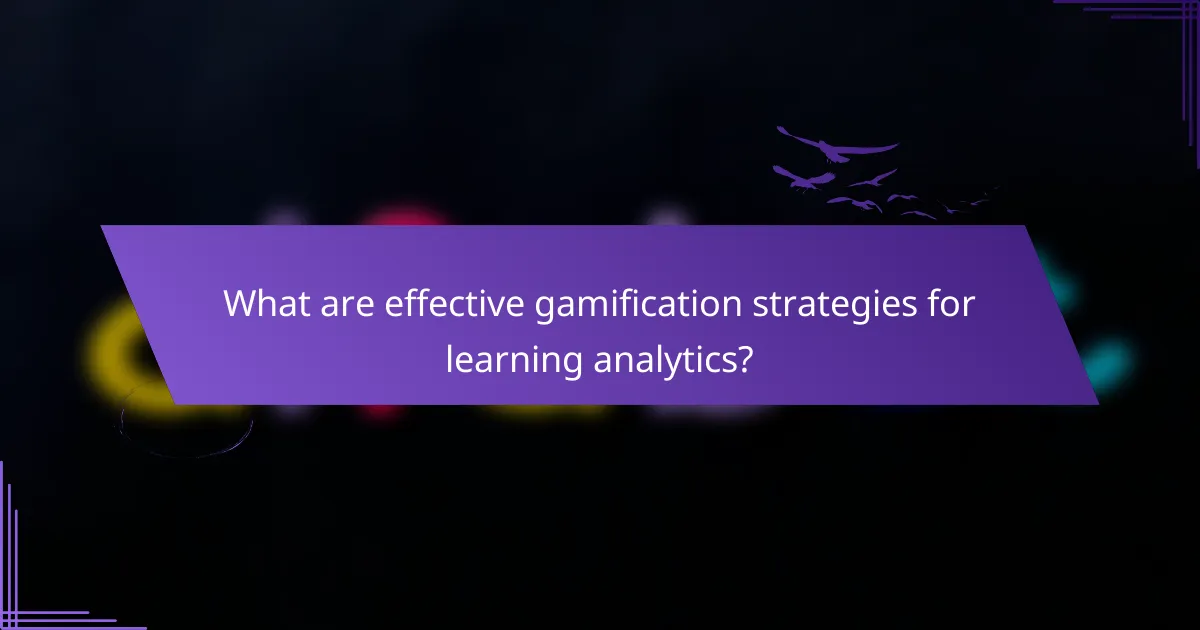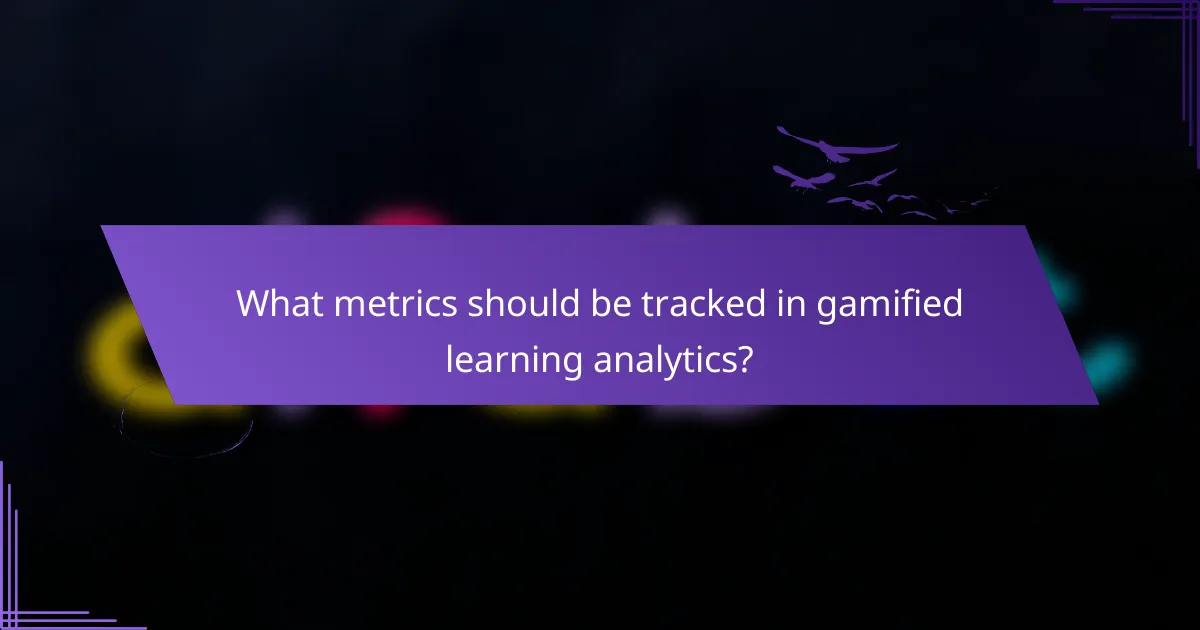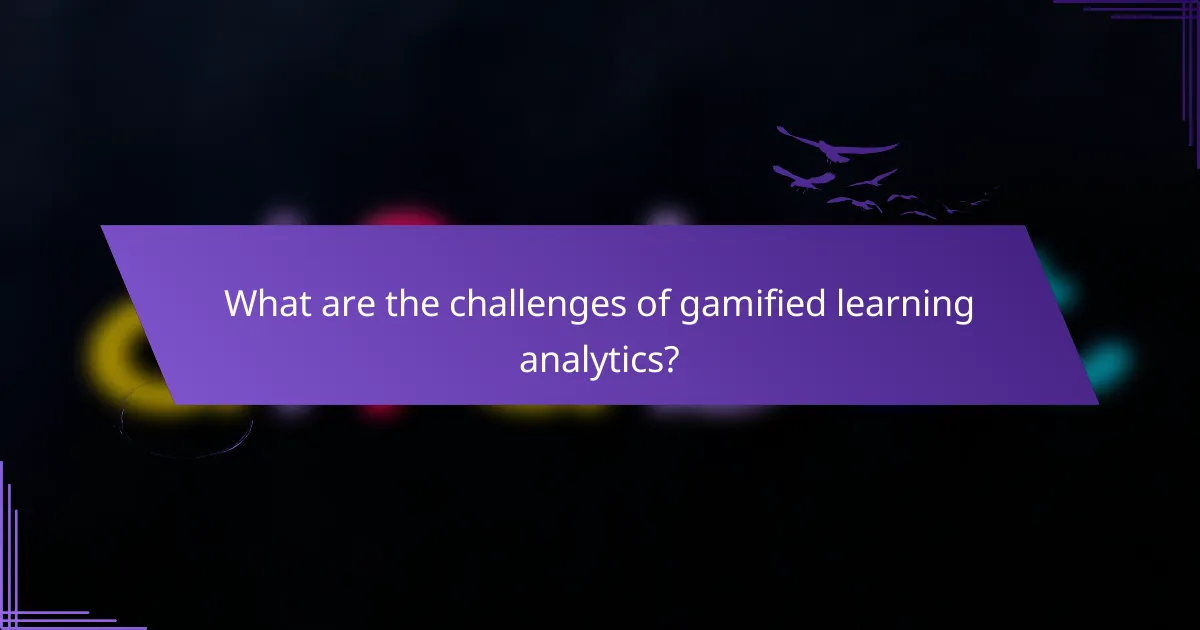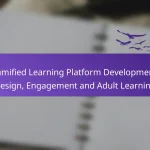Gamified learning analytics combine game-like elements with data analysis to enhance online education, fostering greater student engagement and improved learning outcomes. By utilizing these innovative strategies, educators can gain valuable insights into individual learner needs, allowing for a more personalized and effective educational experience.

How can gamified learning analytics improve online courses?
Gamified learning analytics enhance online courses by integrating game-like elements and data analysis to boost student engagement and learning outcomes. These strategies provide educators with actionable insights that can be used to tailor the learning experience to individual needs.
Enhanced engagement metrics
Gamified learning analytics track student interactions and participation levels, providing clear engagement metrics. By analyzing these metrics, educators can identify which activities captivate students and adjust course content accordingly.
For instance, if a particular game-based quiz shows high completion rates, instructors can incorporate similar formats into future lessons to maintain interest. Regularly reviewing engagement data helps in fine-tuning course elements to keep students motivated.
Personalized learning experiences
Using gamified analytics, educators can create personalized learning paths based on individual performance and preferences. This customization allows students to progress at their own pace, focusing on areas where they need improvement.
For example, if a student struggles with specific concepts, the system can suggest targeted games or activities that reinforce those skills. This tailored approach not only enhances learning but also fosters a sense of ownership over the educational journey.
Data-driven performance insights
Gamified learning analytics provide valuable performance insights by collecting data on student assessments and activities. Educators can analyze this data to identify trends, strengths, and weaknesses within the class.
For instance, if a majority of students perform poorly on a specific topic, instructors can revisit that content or provide additional resources. Utilizing these insights ensures that teaching strategies are aligned with student needs, leading to improved outcomes.
Increased retention rates
Implementing gamified learning analytics can lead to higher retention rates by making learning more enjoyable and relevant. Engaging activities encourage students to stay committed to their courses, reducing dropout rates.
In practice, courses that incorporate gamification elements, such as rewards or leaderboards, often see students returning to complete modules. This approach not only enhances knowledge retention but also builds a community among learners.
Real-time feedback mechanisms
Gamified learning analytics enable real-time feedback, allowing students to receive immediate responses to their performance. This instant feedback loop helps learners understand their progress and areas for improvement without delay.
For example, interactive quizzes can provide instant scores and explanations, guiding students on what to focus on next. This timely information empowers learners to adjust their study habits and strategies effectively, enhancing overall learning efficiency.

What are effective gamification strategies for learning analytics?
Effective gamification strategies for learning analytics involve using game-like elements to enhance engagement and motivation among learners. These strategies can lead to improved learning outcomes by making the educational experience more interactive and enjoyable.
Point systems and rewards
Point systems and rewards are foundational elements of gamification that incentivize learners to engage with content. By assigning points for completing tasks, participating in discussions, or achieving milestones, learners can track their progress and feel a sense of accomplishment.
To implement a point system effectively, consider offering tiered rewards that correspond to different point thresholds. For example, learners might earn badges for reaching 100, 500, or 1,000 points, which can motivate them to strive for higher achievements. Ensure that rewards are meaningful and relevant to the learning objectives.
Leaderboards and competition
Leaderboards create a competitive environment by displaying learners’ rankings based on their performance. This visibility can foster motivation as learners strive to improve their standings relative to peers. However, it’s essential to balance competition with collaboration to avoid discouragement among lower-ranked participants.
When designing a leaderboard, consider using a weekly or monthly reset to allow all learners a chance to shine. Additionally, include categories for different types of achievements, such as most improved or highest collaboration, to recognize diverse skills and contributions.
Interactive challenges and quests
Interactive challenges and quests engage learners by presenting them with tasks that require problem-solving and critical thinking. These challenges can be structured as scenarios or puzzles that relate directly to the learning material, making the experience more immersive.
To create effective challenges, ensure they are appropriately difficult and relevant to the learners’ goals. Incorporate elements such as time limits or resource management to increase engagement. Providing immediate feedback on performance can also enhance the learning experience and encourage continuous improvement.

What tools are available for gamified learning analytics?
Several tools are designed specifically for gamified learning analytics, providing educators with insights into student engagement and performance. These tools leverage game mechanics to enhance learning experiences while collecting valuable data to inform instructional strategies.
Google Analytics for Education
Google Analytics for Education offers educators a powerful way to track user engagement on educational platforms. By setting up goals and events, teachers can monitor how students interact with learning materials, identifying which resources are most effective.
To utilize Google Analytics effectively, educators should focus on key metrics such as user sessions, page views, and bounce rates. Setting up custom dashboards can help visualize data trends over time, allowing for informed decisions about curriculum adjustments.
Kahoot! for engagement tracking
Kahoot! is a popular tool that gamifies quizzes and assessments, making learning fun and interactive. It provides real-time feedback on student performance, allowing teachers to gauge understanding and engagement levels immediately.
Teachers can analyze results after each game, reviewing metrics like correct answers and response times. This data can help identify knowledge gaps and tailor future lessons to address specific learning needs.
Classcraft for gamified learning
Classcraft combines gamification with classroom management, turning learning into a collaborative adventure. It allows educators to track student progress through quests and challenges, fostering a sense of community and motivation among learners.
With Classcraft, teachers can monitor individual and group performance, rewarding positive behaviors and engagement. This tool encourages students to take ownership of their learning, making analytics a natural part of the educational experience.

What metrics should be tracked in gamified learning analytics?
To effectively assess the impact of gamified learning, it’s essential to track metrics that reflect user engagement, completion rates, and learning outcomes. These metrics provide insights into how well learners interact with the content and how effectively they are achieving their educational goals.
Engagement scores
Engagement scores measure how actively learners participate in gamified activities. This can include metrics such as time spent on tasks, frequency of logins, and interactions with game elements like challenges or rewards. High engagement scores typically indicate that learners find the content stimulating and relevant.
To calculate engagement scores, consider using a weighted system that factors in different activities. For example, completing a challenge might carry more weight than simply logging in. Aim for a balanced approach that reflects both quantity and quality of engagement.
Completion rates
Completion rates indicate the percentage of learners who finish a course or specific module within the gamified learning environment. This metric is crucial for understanding learner persistence and the effectiveness of the course design. A low completion rate may suggest that the content is too challenging or not engaging enough.
To improve completion rates, consider implementing checkpoints or incentives for reaching certain milestones. For instance, offering rewards for completing 50% of a module can motivate learners to push through to the end. Regularly review these rates to identify trends and make necessary adjustments.
Learning outcomes
Learning outcomes assess the effectiveness of gamified learning in achieving educational objectives. This can be measured through assessments, quizzes, or practical applications of knowledge. Tracking these outcomes helps determine whether the gamified approach is translating into real-world skills or knowledge retention.
To evaluate learning outcomes effectively, set clear, measurable goals at the outset. Use pre- and post-assessments to gauge improvement and adjust the learning experience based on the results. Aim for a holistic view that considers both knowledge gained and the application of that knowledge in practical scenarios.

How do you implement gamified learning analytics in online courses?
Implementing gamified learning analytics in online courses involves integrating game-like elements into the learning process while leveraging data to enhance engagement and performance. This approach not only motivates learners but also provides valuable insights into their progress and areas for improvement.
Define learning objectives
Clearly defined learning objectives are essential for effective gamified learning analytics. These objectives should outline what learners are expected to achieve and how success will be measured. For instance, objectives might include mastering specific skills or completing a series of challenges within a set timeframe.
When setting these objectives, consider using the SMART criteria—Specific, Measurable, Achievable, Relevant, and Time-bound. This ensures that the goals are clear and attainable, providing a solid foundation for the gamification strategy.
Select appropriate tools
Choosing the right tools is crucial for implementing gamified learning analytics effectively. Look for platforms that offer built-in analytics features, such as learning management systems (LMS) with gamification capabilities. Popular options include Moodle, Canvas, and Edmodo, which allow for tracking learner progress and engagement.
Additionally, consider integrating third-party tools that specialize in gamification, like Kahoot! or Classcraft. These tools can enhance the learning experience by adding interactive elements and real-time feedback.
Design gamification elements
Designing engaging gamification elements is key to capturing learners’ interest. Common elements include points, badges, leaderboards, and challenges that encourage competition and collaboration. For example, awarding points for completing quizzes or badges for reaching milestones can motivate learners to engage more deeply with the content.
Ensure that these elements align with the defined learning objectives. This alignment helps maintain focus on educational outcomes while making the learning experience enjoyable.
Analyze and iterate
Regular analysis of the data collected through gamified learning analytics is essential for continuous improvement. Monitor learner engagement, performance metrics, and feedback to identify trends and areas needing adjustment. For example, if many learners struggle with a specific challenge, it may require re-evaluation or additional support.
Iterate on your gamification strategy based on these insights. This might involve tweaking game mechanics, adjusting objectives, or introducing new elements to keep the learning experience fresh and effective. Regular updates can significantly enhance learner satisfaction and outcomes.

What are the challenges of gamified learning analytics?
Gamified learning analytics face several challenges that can hinder their effectiveness. Key issues include data privacy concerns, the complexity of accurately measuring engagement, and the potential for misinterpretation of analytics results.
Data Privacy Concerns
Data privacy is a significant challenge in gamified learning analytics, as educational institutions must comply with regulations like GDPR in Europe or FERPA in the United States. These regulations impose strict guidelines on how student data can be collected, stored, and used.
To navigate these concerns, institutions should prioritize transparency with learners about data usage and implement robust data protection measures. Ensuring that data is anonymized and securely stored can help mitigate privacy risks.
Measuring Engagement Accurately
Accurately measuring engagement in gamified learning can be complex due to the variety of metrics available, such as time spent on tasks, completion rates, and interaction frequency. Each metric can provide different insights, making it challenging to determine what truly reflects learner engagement.
Educators should focus on a balanced set of metrics that capture both quantitative and qualitative aspects of engagement. For example, combining completion rates with feedback surveys can offer a more comprehensive view of learner involvement.
Misinterpretation of Analytics Results
Misinterpretation of analytics results can lead to misguided decisions in educational strategies. For instance, high engagement metrics might be misread as effective learning, while they could simply indicate that students are spending time on less impactful activities.
To avoid this pitfall, educators should contextualize analytics results within the broader learning objectives. Regularly reviewing and discussing analytics with stakeholders can help ensure that interpretations align with educational goals.


